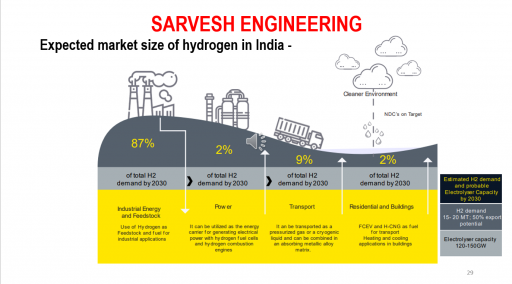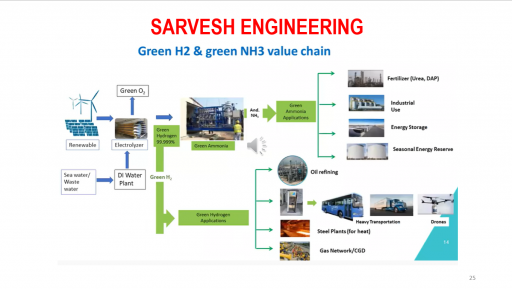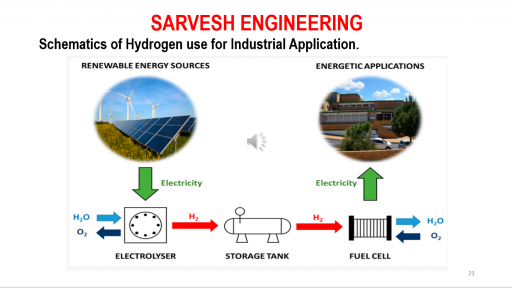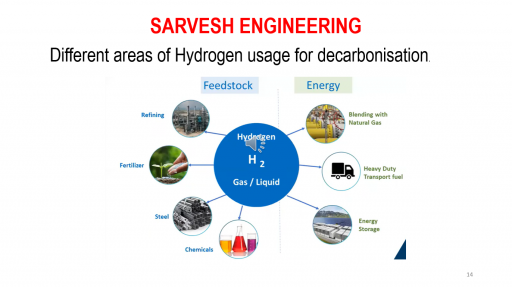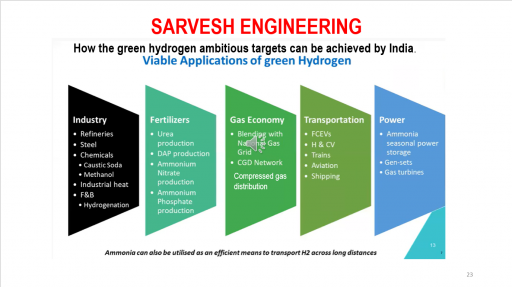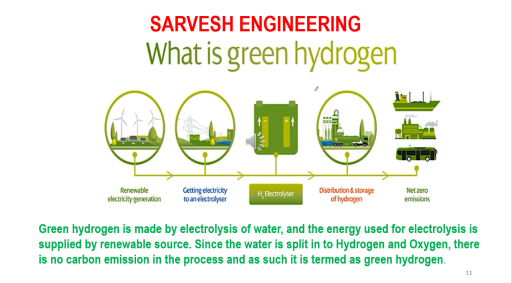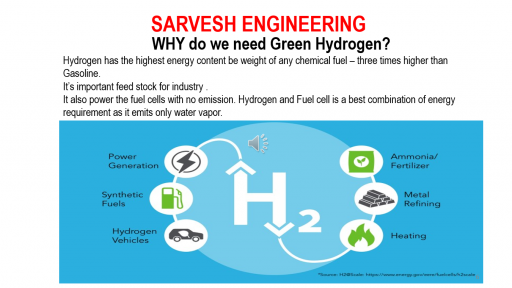Industry
Automotive, Fertilizer, Amonia, Steel, Energy
Technology origin
Europe
Technology status
Available for commercial deployment
Principal of operation
Water molecules are disintegrated in to Hydrogen and oxygen with the help of electricity. The hydrogen is purified and stored at high pressure for different applications.
Read more
Scope
Turnkey Project
Features
Hydrogen fact sheet ---
Although Hydrogen is available in abundance it is not available in free form, it is combined with some other elements, and need to be extracted for its use.
Hydrogen has a very high calorific value compared to Petrol it is about 10 times more.
Hydrogen has very low density and it is highly inflammable.
Hydrogen flame speed is 10 times faster than petrol/diesel flame speed.
Hydrogen burns very close to combustion chamber walls and as such requires extremely efficient thermal management.
Hydrogen is compressed to about 700 bar for automotive use application.
Hydrogen efficiency to wheel is about 25%, where as fuel cell efficiency is about 60%
Hydrogen boils at – 253 C, where-as the critical point is at - 240 C, and as such it is very difficult to store.
Flamability – H2 burns when mixed with Air in the ratio of 4 to 76%, Fuel needs a ratio of 1.4 to 7.6%.
Hydrogen requires very low amount of air/oxygen to burn.
High auto ignition temperature – at 500 C, where-as for petrol it is about 220 to 300 C
Hydrogen is transported as a gas for less than 1500 km, distance, for longer distance it is transported as liquid (liquid organic hydrogen carrier)
Hydrogen can be blended with natural gas, CNG, LPG, or other fossil fuel in small portions.
Hydrogen is transported in the form of AMONIA and hydrogen is extracted back when requires. Liquify ammonia has a density of 10.7 kg H2/100 l
Hydrogen is 11 times lighter than air.
11.1 Nm3 Hydrogen weighs 1 kg
1 kg Hydrogen requires about 4.5 KW of power for generation.
1 kg Hydrogen has energy value of 33.3 KWH.
Purity required for fuel cell –99.999
Hydrogen flow rate unit – Nm3/hr
Oxygen generation – 50% of hydrogen generation.
Hydrogen pressure – 15 to 30 bar usually, in some case 50 bar.
Feed water consumption <4 l/Nm3H2
Although Hydrogen is available in abundance it is not available in free form, it is combined with some other elements, and need to be extracted for its use.
Hydrogen has a very high calorific value compared to Petrol it is about 10 times more.
Hydrogen has very low density and it is highly inflammable.
Hydrogen flame speed is 10 times faster than petrol/diesel flame speed.
Hydrogen burns very close to combustion chamber walls and as such requires extremely efficient thermal management.
Hydrogen is compressed to about 700 bar for automotive use application.
Hydrogen efficiency to wheel is about 25%, where as fuel cell efficiency is about 60%
Hydrogen boils at – 253 C, where-as the critical point is at - 240 C, and as such it is very difficult to store.
Flamability – H2 burns when mixed with Air in the ratio of 4 to 76%, Fuel needs a ratio of 1.4 to 7.6%.
Hydrogen requires very low amount of air/oxygen to burn.
High auto ignition temperature – at 500 C, where-as for petrol it is about 220 to 300 C
Hydrogen is transported as a gas for less than 1500 km, distance, for longer distance it is transported as liquid (liquid organic hydrogen carrier)
Hydrogen can be blended with natural gas, CNG, LPG, or other fossil fuel in small portions.
Hydrogen is transported in the form of AMONIA and hydrogen is extracted back when requires. Liquify ammonia has a density of 10.7 kg H2/100 l
Hydrogen is 11 times lighter than air.
11.1 Nm3 Hydrogen weighs 1 kg
1 kg Hydrogen requires about 4.5 KW of power for generation.
1 kg Hydrogen has energy value of 33.3 KWH.
Purity required for fuel cell –99.999
Hydrogen flow rate unit – Nm3/hr
Oxygen generation – 50% of hydrogen generation.
Hydrogen pressure – 15 to 30 bar usually, in some case 50 bar.
Feed water consumption <4 l/Nm3H2
Application
Automotive industry, Fertilizer industry, Steel industry, Energy storage, Marine application, Railways, Aviation industries etc.
